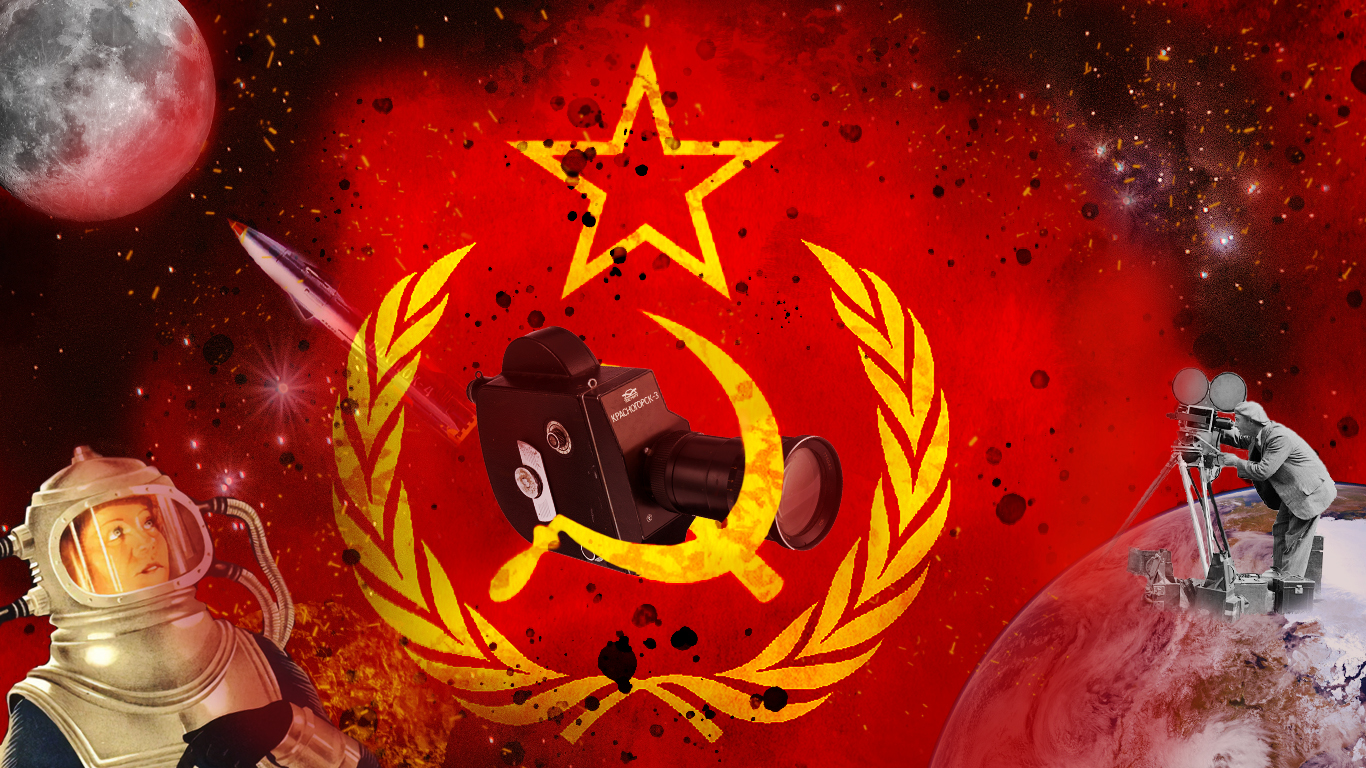The flying worlds of science fiction films and series from the 1960s to the 1980s, popular on both sides of the Iron Curtain, today appear at least as alien to us, if not more so, than they did fifty years ago. However, their current alienness is usually described as "retro" or "nostalgic", sometimes even (naively?) humanist as opposed to futuristic. Apart from a certain design or aesthetic, nostalgia for the space age of the twentieth century is often linked to assumptions about a brighter, happier future that were once widespread and now are gone for good. This kind of "nostalgia for the past future" is commonly associated with Eastern European former socialist societies and their popular cultural production. As films, television series, and music videos become increasingly accessible to wider audiences on digital streaming platforms, they transition from the "archive" to the "exhibition window", inviting reassessment, including of collective memory, genre, and utopia. In this context, Soviet space utopias attract a significant amount of attention, fuelling speculation about communism's projected futures, Amero-Soviet cultural exchange, and details about the production and reception contexts of famous films, such as Andrei Tarkovsky's Solaris (1972).
Popular-cultural references point to various aspects of the bygone space age, particularly its cultural and socio-political dimensions, and allow us to decode what kinds of philosophical, popular-scientific, aesthetic, technological, as well as the political and national imaginaries to which a particular space age belonged. At the same time, all of these imaginaries have evolved and been integrated into our collective memory – the assemblage of means or pathways into the past (media, technologies, and narratives) as well as the contents that these relate to (words, ideas, plots, and physical objects either coming directly from the past or commemorating it). To cut a long theoretical discussion short: what is socially communicated about an event does not necessarily coincide with the event's material ramifications. Collective memory and remembrance depend greatly on the policies and contingencies that allow certain texts to rise above the archives and other texts to be buried in them. Because of this, returns to the archives are particularly welcome during periods of debate over meanings and narratives, which are inevitably located at the crossroads of fiction and evidence, projection and historicization. It makes sense to reconsider the significance of science fiction cinema in the context of our collective memory of the space age, particularly as rumours about feats of new space exploration grow louder and are no longer reserved to national initiatives or governed exclusively by real-political agendas, and also as often nostalgic film productions about the history of the space race multiply.
Where to Begin Excavating Past Futures?
Science fiction cinema offered images and narratives about the space age from long before the launch of the first space programs, let alone satellites. The long history of this cinematic genre further suggests that the space age perhaps even needed to be narrated and realistically visualized before its inaugural events could take place, and that these events had to be recorded, that is filmed, in order to be at first believable and then disputable not long afterwards. Science fiction's imaginary depiction of the space age thus oscillates between belief (in technical, sociopolitical, and/or moral progress) and doubt. Furthermore, literary and cultural studies scholars have convincingly shown the persistence of certain overlaps or at least correspondences between existing societal problems and concerns, and the preoccupations of science fiction productions (books, films, series, videogames, etc.). It is therefore no surprise that utopian visions of spacefaring societies were a particularly common science-fiction trope of the twentieth century and its space age. The origins of the recent increase in popular and academic interest in past imaginaries of future societies are particularly interesting, as they coincide partly with a new interest in space exploration and partly with nostalgic (post)memories of twentieth-century utopias. All of these factors have contributed to a profound reevaluation of the symbolic, technological, aesthetic, and political significance of the once vanguard (or at least current) and now archived twentieth-century popular culture and its canons. Today these are being renegotiated at the crossroads of fandom, scholarship, and technology, drawing on newly available archival material, convincing academic case studies, and networks such as fan forums. Over the past two decades, these stakeholders have profoundly reshaped the international collective memory of twentieth-century space-age futures, creating space for an international polylogue between not only cinematic famous masterpieces – such as 2001: A Space Odyssey (1968), Solaris (1968), Solaris (1972), and Solaris (2002) – but also between lesser-known productions from a range of national and ideological backgrounds. Finally, imaginaries of "the space-age future", once predominantly considered in chronological order as a reflection of technological progression and sociopolitical transformation, now form an estranged bricolage, a (media)archaeological site, and an exhibit of unexpected encounters between aesthetic styles, production contexts, and axiological positions. Perhaps most significantly, this rearrangement intervenes into one of the most influential discussions about the political potential of science fiction utopias initiated by Darko Suvin and embraced by Fredric Jameson. In an essay published as part of The Blagoevgrad Theses, Suvin, for whom utopia is "the sociopolitical subgenre of science fiction", influentially remarked that:
Suvin's statement aligns utopia with a political program, with the utopia of an egalitarian, communist society. While this might indicate a preference for a certain selection of canonical texts, Suvin's definition of the "radically liberating" novum involves a temporal vector and situates futuristic utopia in critical dialogue with the history of humanism that should in turn ideally account for the history of utopianisms and their representations. Therefore, each new take on futuristic utopia as an imaginary society should ideally be treated in conversation with previous ones. All opposition to social and natural degradation must be confronted with the outcomes of analogous past projects and projections; the archive of utopian desires, projects, and texts haunts the canon of chef-d'oeuvres focused on privileged media such as literature.
Soviet Space Cinema beyond Fiction, beyond Science, and against Canon: The Contours of an Imaginary
As if inspired by this Suvinian methodological reflection, the Russian Space Agency's television channel TV Roscosmos has spent the past decade developing and updating an online database that lists and, when possible, provides links to Soviet and post-Soviet Russian feature films "about outer space and cosmonautics" (Rus. o kosmose i kosmonavtike). This archive consists of more than thirty feature films, ranging from early twentieth-century fantastic projections such as Aelita: Queen of Mars (1924) and Cosmic Voyage (1936), the socialist-realist space utopias of museum-like communist societies characteristic of the 1950s and 1960s, to didactic and fairy-tale-like youth science fiction from the 1970s, unique introspective masterpieces such as Tarkovsky's aforementioned Solaris (1972), postmodernist auteur films from the 1990s and 2000s, and thrilling and spectacular rearticulations of events from the history of the Soviet space program. This archive is conceptually interesting in its cross-genre focus on "outer space", harnessing the Soviet tradition of treating science fiction as a close relative of the popularization of science, and featuring historical, science fiction, popular science, and melodramatic productions alongside one another. Moreover, the platform makes it easy to trace the continuities and transformations of space-age related ideas in the (post)Soviet cinematic imaginary across an extended time span, from utopia to memory. (For an in-depth analysis of this, see Majsova 2021). Now let's have a look at how these two notions interact, or, in other words, what influence futuristic projections appear to exert on historical narratives.
Utopian Impulse: To See is to Know and to Question
The archival perspective on Soviet science fiction and its imaginary of the space age debunks the stereotype about the introverted, pensive character of Soviet science fiction cinema, characteristic, for instance, of Tarkovsky's oeuvre. Moreover, close readings of various space-related films from different time periods contextualize the significance of the idea of encountering radical alterity or visualizing life as abstract becoming, often associated with the emancipatory potential of science fiction, or its utopian impulse to paraphrase Fredric Jameson. Although explored in depth by certain individual directors, this impulse actually never belonged among the privileged questions of the genre of science fiction or space-themed films. Statistically speaking, up until the late 1980s, Soviet science fiction cinema mostly consisted of productions that glorified and monumentalized the space-age future as the imminent achievement of communism and, in this context, as the realization of the Cosmos: harmony, wellbeing, and the absence of misunderstanding and insecurity. Nevertheless, a specific kind of attention to radical alterity seeps through the seams of some of these films, which maintain a highly explorative attitude to the space age as the socialist future. This can be discerned in the abstract visualizations of the richness of outer space and possible extra-terrestrial life, which was characteristic of Pavel Klushantsev's works popular science and science fiction films, and those influenced by his approach to special effects, such as I Was a Satellite of the Sun (1959). If aligned with becoming and dynamism proper, the emancipatory utopian impulse both appreciates and celebrates a profoundly renewed, egalitarian, and progressive social contract, and can be found in several atypical space films. These include the future-oriented silent melodrama Aelita (1924), which celebrates post-revolutionary Moscow "under construction", and obscure, critically underappreciated science-fiction films, such as The Mysterious Wall (1967), which scrutinizes the future of interpersonal relations and interspecies communication, and Moon Rainbow (1983). Apart from science fiction, the conceptual significance of the space age as a ground-breaking event that can bring about a new set of priorities, values, and attitudes toward the past, is characteristic of several post-Soviet Russian auteur productions such as Dreaming of Space (2005) and First on the Moon (2005), both of which are preoccupied with redefinitions of historical events and timelines. While belonging to different genres, The Mysterious Wall, Moon Rainbow and both films mentioned in this paragraph show that the utopian impulse as understood by Suvin is not necessarily governed by temporal vectors underlying orientations such as "past" and "future". In the archives of Soviet and post-Soviet space feature films, the utopian relates more to the elsewhere than to the past or future; and this elsewhere can be communicated with equal efficiency by using a variety of narrative and visual solutions.
Utopian Form: From Instructive Space Utopias to Mythical Historical Blockbusters
While the utopian impulse characterizes a select few productions, rather than the entire genre of Soviet science fiction cinema, the most striking constant of the larger genre concerns the idea of instructive utopian projections of the space-age future. Film historians tend to associate this thematic emphasis with narratives of socialist-realist and socialist-realist-influenced productions of the late 1950s and early 1960s such as The Heavens Call (1961), Toward Meeting a Dream (1963), The Andromeda Nebula (1967), and 1970s youth science fiction such as Moscow-Cassiopeia (1973) and Teens in the Universe (1974). Apart from being simple representations of an anticipated communist social order in the space age, these films conjoin ideas of a museum-like communist future in space with traditional value hierarchies. These include respect for elders, strict heteronormativity, rigid gender roles that mark women as mothers, wives, and sidekicks, and tacit affirmations of Russian-Soviet intellectual superiority. In the quasi-conflictless worlds of these films, in which narratives are not supposed to excite but rather to convince by developing a certain topic, these ideas were consistently generated as latent byproducts of the plot.
This observation is supported by Evgeny Dobrenko's insightful remark about Stalinist film narratives:
Although the Stalinist doctrine of socialist realism was denounced by Nikita Khrushchev at the 20th Communist Party Congress in 1956, this mnemonic future-oriented agenda appears to persist in certain later, post-Stalinist productions, notably in the genres of space-concerned popular science and science fiction films, as if the intent of the films were to equip Soviet citizens with instructions for how to approach the coming space age. Until the 1970s, Soviet space science fiction films were mostly illustrations of gentle, didactic narratives that offered a distanced perspective on the "now" in order to inspire faith in an even better, communist future. In fact, they were often straightforwardly – and often in contrast to the literary texts they were based on – framed as the dream of one of the protagonists, which was supposed to be regarded from afar, rather than actually visited or experienced. This device probably ensured the reception of the film as pure fiction, unrepresentative of reality. Despite this disclaimer, it was film (and sometimes theatre, though not literature) that often got accused of simplicity in its visualizations of alterity. It should be noted that the static form and traditional orientation of the majority of Soviet space utopias need not be considered a peculiarity of cinematic world-building, but rather a reflection of the films’ social mnemonic function. Instead of offering "radically liberating" novums, socialist-realist-inspired space futures and narratives of the history of the Soviet space program seek to reinforce the stability of a certain traditionalist, and future-oriented, symbolic imaginary across time, genre, and aesthetic preferences. As if remembering these "instructions" in an inverted way, as stories about life in the Soviet past, these very narrative structures and messages reappeared in recent Russian historical space thrillers such as The Age of Pioneers (also known as The Spacewalker) (2017) and Salyut-7 (2017), which follow the same idealistic logic of prompting the viewers to identify with the protagonist who is aspiring to create a better future. However, the fictional narratives are "based on historical events" rather than manifested as dreamy visions of the future.
In the context of this discussion on the presence of the space age in post-Soviet collective memory, these space thrillers articulate a nostalgia for a certain historical narrative (of Soviet supremacy in the space race), and for the form of the idealistic, dreamy fictions that were popular in the 1950s, 1960s, and early 1970s. This twofold nostalgia for a lost utopia, detectable in these recent action films, differs from the characteristic of the reflexive, inquisitive productions from the 2000s such as the aforementioned Dreaming of Space and First on the Moon, which are comparable in their restless impulse but very different in form. Having embraced the utopian impulse to construct anew and to reconstruct in a better way (albeit not utopia as a predefined form), these films attempt to align nostalgia with the past with a diverse, as opposed to a particular interpretation of the past. In this context, their immediate successors, the fantastic blockbusters about the glory of the Soviet space program, historical fiction science productions, can hardly be interpreted as a mere stylistic transformation.















